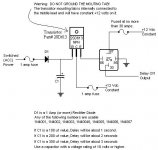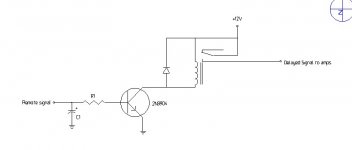Im helping a friend hook up a system in his truck..
The problem he's having if turn-off pop thru the subwoofer..
I heard i can add a cap and diode on the remote wire to solve this problem..
Or is there a better circuit i can make for this??
Is the cap and diode will work what size cap would i need and what diode would i need??
how do i wiire this up??
The problem he's having if turn-off pop thru the subwoofer..
I heard i can add a cap and diode on the remote wire to solve this problem..
Or is there a better circuit i can make for this??
Is the cap and diode will work what size cap would i need and what diode would i need??
how do i wiire this up??
this is a common problem... the source signal is being removed before the capacitors in the amp discharge.
Here's how to do it with just a diode and a cap... the diode should be a rectifier of some sort, something like 1N4004 would be fine. The Value of the cap will depend on how much current the remote sense line of your amps will be, what the dropout voltage is, and how long it takes the amp's capacitors to drain. the capacitor should be pretty large so you can get a few seconds delay on the line, something like 1000uF perhaps... just a guess to get you started.

A better way to do it so it doesn't matter how much current your amp sense line would be to use a relay... the cap discharges throught the relay coil, and the relay contacts provide a nice clean delayed remote signal to the amp. again exact value for the capacitor depends on the current requirement of the relay, but doing it this way, you could switch all your amps, or future amps and they will all shut off at the same time. it also provides a cleaner signal than the diode-cap only method, because in this instacne, the capacitor will be discharging at a steady rate through the amp's circuitry, not an ON/OFF signal as the input to the amp is expecting.
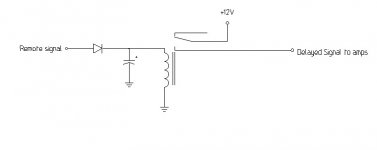
The best way to do it is with a transistor instead of a diode.. you can use a much smaller cap this way. the C1 and R1 form an RC timing circuit, the resistor limits the drain on C1. R1 should be betweeen 1K and 10K C1 probably around 20uF or so... I am just guessing at the values, this will take some expirimentation. The transistor can be any small NPN type and again the exact values will depend on the relay and transistor used.
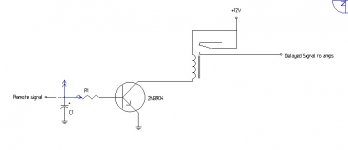
Here's how to do it with just a diode and a cap... the diode should be a rectifier of some sort, something like 1N4004 would be fine. The Value of the cap will depend on how much current the remote sense line of your amps will be, what the dropout voltage is, and how long it takes the amp's capacitors to drain. the capacitor should be pretty large so you can get a few seconds delay on the line, something like 1000uF perhaps... just a guess to get you started.

A better way to do it so it doesn't matter how much current your amp sense line would be to use a relay... the cap discharges throught the relay coil, and the relay contacts provide a nice clean delayed remote signal to the amp. again exact value for the capacitor depends on the current requirement of the relay, but doing it this way, you could switch all your amps, or future amps and they will all shut off at the same time. it also provides a cleaner signal than the diode-cap only method, because in this instacne, the capacitor will be discharging at a steady rate through the amp's circuitry, not an ON/OFF signal as the input to the amp is expecting.

The best way to do it is with a transistor instead of a diode.. you can use a much smaller cap this way. the C1 and R1 form an RC timing circuit, the resistor limits the drain on C1. R1 should be betweeen 1K and 10K C1 probably around 20uF or so... I am just guessing at the values, this will take some expirimentation. The transistor can be any small NPN type and again the exact values will depend on the relay and transistor used.

Would this circuit work?? If so what NPN Transistor could i use??
that would work... quite overkill if you ask me... even a 2N3904 transsisor is way overkill.. the 30AMP fuse to power relay made me laugh! if you wanted to fuse it, put just ONE fuse to run the circuit and supply the relay, personally I would not bother, the whole thing is running off milliamps, the signal both in and out is also milliamps... and the whole thing ends up getting fused from wherever you swiped your +12 feed from anyway, putting more fuses all over the place is just a waste of time and more places for things to go wrong.
you do not need that giant relay they have shown.. ANY relay would work, as long as it has a 12VDC coil.. radio shack sells some nice small ones you pretty much want the smallest 12V coil relay you can find. the remote signal going into your amp only takes a few milliamps
Would this circuit work?? If so what NPN Transistor could i use??
This is also missing a resistor on the base of the transistor... transistors should always have a current limiting resistor on the base, and if this one had one, it would not need such large capacitors to get the desired delay... and it would burn out far less transistors.
No no no... wait... hold on... this is ALL wrong... all of it... the problem is the amp is staying on too long as it is already... you need to delay the head unit from turning off until the caps in the amp discharge... you can't use the remote out from the head unit, it won't work. use the switched 12v line as the input to the circuit, and hook up the output to the head units switched 12V input... you can also have the reverse problem on power up.. if the amp is up and ready to go before the head unit gets it's outputs turned on, this causes a pop when you power up.. the schematic below solves both problems by delaying the amp on power up and delaying the head unit on power down.
for the power on delay, R3 should be smaller than R2, perhaps make R3 1K and R2 10K when I used to do this I would use a protoboard to get the resistors and capacitors the way I wanted them, then solder it on a breadboard once I got it the way I wanted it. Radio shack used to sell bulk packs of resistors and electrolytic capacitor and it was a great way to have a lot of different values to play around with. ah.. the good old days when radio shack had walls and walls of nothing but electronic componenets, and no over priced cell phones.
if you want just the off delay on the head unit, hook up the remote to the amps directly to the switched 12v line.. they will shut off right away while the head unit stays on until the amps caps are discharged.
Sorry it's taking me so long to get this right, it's almost 3am here
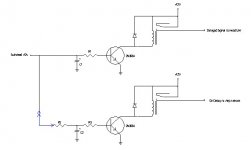
for the power on delay, R3 should be smaller than R2, perhaps make R3 1K and R2 10K when I used to do this I would use a protoboard to get the resistors and capacitors the way I wanted them, then solder it on a breadboard once I got it the way I wanted it. Radio shack used to sell bulk packs of resistors and electrolytic capacitor and it was a great way to have a lot of different values to play around with. ah.. the good old days when radio shack had walls and walls of nothing but electronic componenets, and no over priced cell phones.
if you want just the off delay on the head unit, hook up the remote to the amps directly to the switched 12v line.. they will shut off right away while the head unit stays on until the amps caps are discharged.
Sorry it's taking me so long to get this right, it's almost 3am here

hmm, here is an idea..... check the remote from the head unit, and compare it to the vehicle accy. power. see if the head unit is actually delaying cutting power to the remote wire. if so, then you can install a relay behind the dash, using vehicle acc as the power source, and the remote from the head unit as the trigger. this way, you know the remote power is cut off without delay. now, if there is no delay, well, you can still do exactly the same, and install a delay to the acc into the head, and delay the head from turning off until after the amp has shut off. of course, you may be barking up an imaginary tree with all this delaying buisiness, but nobody knows untill you have either a- did all this and it did not work, or b-(the easier way to find out) answer perry's question.....also, to add to his question, leave the head on with no sound playing, and manually turn the amp on and off. report what you find please.
see if the head unit is actually delaying cutting power to the remote wire. if so, then you can install a relay behind the dash, using vehicle acc as the power source...
if the head unit is delaying the remote signal, you could just tie the remote signal directly to the switched power.. or acc. or whatever you use to switch on the system. there is really no reason this has to go through the head unit at all, and no reason it could not be tied directly to switched power.
However I suspect this has more to do with the amp staying on due to charged caps while the input signal is lost. if you end up needing a delay, then I would defiantly recommend a relay circuit.
yes that is true... now I remember why I ended up with my own power switch for the system.. well being able to turn everything off while driving was one reason, running everything till the battery was dead while the car was parked was the other reason. I had a second isolated battery for the audio system so I could do that and still drive off.
This doesn't solve the problem of noise if you shut off the head unit, and leave the switch on, but I just got in the habit of using my switch all the time
This doesn't solve the problem of noise if you shut off the head unit, and leave the switch on, but I just got in the habit of using my switch all the time
Sorry if I'm sort of hijacking this thread a bit, but this is exactly what I require.
How would I be able to use one of these circuits to delay powering off a HU?
Reason being getting out and in of a car for quick deliveries, upon restarting my vehicle the HU requires a bit of time to read disk before it resumes playing. This is very annoying.
I know I would need to adjust cap size accordingly to achieve a 1 minute delay.
My main concern is upon restarting the vehicle with my audio system running will it cut power to it like a usual restart?
On the flip side, if the audio system were able to stay running during restarting of the engine. Will there be any adverse effects to the audio system thru the electrical wiring while cranking on the starter with it's high current draw like feedback or spikes?
I apologize if I'm off base here and will start a new thread if need be.
How would I be able to use one of these circuits to delay powering off a HU?
Reason being getting out and in of a car for quick deliveries, upon restarting my vehicle the HU requires a bit of time to read disk before it resumes playing. This is very annoying.
I know I would need to adjust cap size accordingly to achieve a 1 minute delay.
My main concern is upon restarting the vehicle with my audio system running will it cut power to it like a usual restart?
On the flip side, if the audio system were able to stay running during restarting of the engine. Will there be any adverse effects to the audio system thru the electrical wiring while cranking on the starter with it's high current draw like feedback or spikes?
I apologize if I'm off base here and will start a new thread if need be.
I suggest you look at a mute circuit.
Delay the mute release at switch on, to allow time for circuits to settle and relays to trigger.
Instant mute when power off. That cuts the Audio Signal before any other circuits start to shut down.
The mute could be a signal relay to audio ground, but I would go with a small signal FET with an appropriate control signal for the timings required.
Delay the mute release at switch on, to allow time for circuits to settle and relays to trigger.
Instant mute when power off. That cuts the Audio Signal before any other circuits start to shut down.
The mute could be a signal relay to audio ground, but I would go with a small signal FET with an appropriate control signal for the timings required.
ttimbo:
A DPDT switch could make the system do what you'd like but you'd have to remember to switch it back when you leave the vehicle for longer than a few minutes.
One side of the DPDT switch wired to the remote for the amps.
Center terminal wired to the amp remote terminal.
Top terminal wired to a switched power source. The one used for the head unit's switched wire would be OK.
Bottom terminal wired to the head unit's remote
Other side of DPDT switch wired to the ignition wire for the head unit.
Center terminal to head unit's ignition wire
Top terminal wired to a constant power source
Bottom terminal wired to the wire that's normally used for the head unit's ignition wire
In one position, the head unit would remain on so the CD player wouldn't shut off. In this position, the amp's remote would be powered by the vehicle's ignition/switched source. The amp would go on and off with the key. This would prevent the amp from playing when you were out of the vehicle.
In the other position, the system would work normally (amp and head unit on and off with the key).
A DPDT switch could make the system do what you'd like but you'd have to remember to switch it back when you leave the vehicle for longer than a few minutes.
One side of the DPDT switch wired to the remote for the amps.
Center terminal wired to the amp remote terminal.
Top terminal wired to a switched power source. The one used for the head unit's switched wire would be OK.
Bottom terminal wired to the head unit's remote
Other side of DPDT switch wired to the ignition wire for the head unit.
Center terminal to head unit's ignition wire
Top terminal wired to a constant power source
Bottom terminal wired to the wire that's normally used for the head unit's ignition wire
In one position, the head unit would remain on so the CD player wouldn't shut off. In this position, the amp's remote would be powered by the vehicle's ignition/switched source. The amp would go on and off with the key. This would prevent the amp from playing when you were out of the vehicle.
In the other position, the system would work normally (amp and head unit on and off with the key).
- Status
- This old topic is closed. If you want to reopen this topic, contact a moderator using the "Report Post" button.
- Home
- General Interest
- Car Audio
- Turn Off Delay Circuit.
